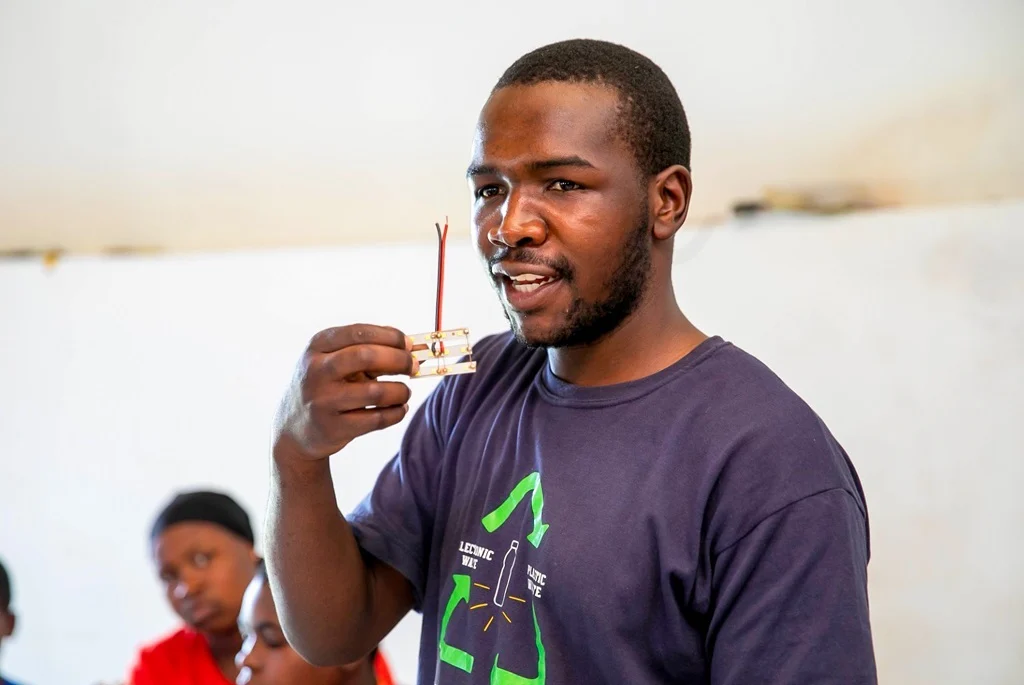Aluwaine Tanaka Manyonga’s fingers trace the familiar ridges of the plastic container he holds as he sits perched on a chair, his gaze sweeping over the rapt faces of a room full of students bathed in the warm glow of his invention, the Chigubhu Lantern.
Manyonga’s entrepreneurial catchphrase, “A light for every student,” is being taken seriously by his audience, for whom a repurposed bottle has, in the course of this lecture, been transformed into a flickering beacon of hope.
As he weaves his tale, Manyonga sees not just recycled plastic but the potential for brighter futures in rural Zimbabwe, where in many villages, darkness still drapes the evenings like a heavy cloak. His creation isn’t just a clever contraption; it’s a promise of extended study hours, improved grades, and ultimately a chance to rewrite students’ destinies.
And in the flickering light reflected in the students’ wide eyes, Manyonga finds his purpose reaffirmed; a fire is kindled by the spark of hope his class ignites in each young mind.
Throughout his college years, Manyonga experienced serious power outages, which could last up to 19 hours a day. This disrupted his practical sessions during the day and made night studies nearly impossible.
As an electrical engineering graduate at the University of Zimbabwe, he felt deeply that he and others needed a solution that was homemade and accessible. Since store-bought solar lamps and batteries were too expensive, his struggle was shared by students across the country, as well as rural children wishing to study at night.
In response to this challenge, Manyonga conceived the Chigubhu Lantern, in 2018. He aimed to transform the concept of lighting, and at the same time, facilitate his night-time studies, he explained.
“The severity of the power cuts reached such a level that studying at night became completely unfeasible,” Manyonga said.
The Chigubhu Lantern is crafted from discarded electronic waste and can also provide reliable light to entire families.
“One notable feature is its centralised solar charger, enabling multiple lanterns to be charged simultaneously. This innovation directly addresses the persistent power shortages faced in Zimbabwe and it helped me during my studies,” Manyonga explained.
While Manyonga had initially focused on providing light for students and families in urban areas, he soon began thinking about how to provide solutions for rural families.
Manyonga is hardly alone when it comes to finding solar solutions in Africa. South Africa alone added 3 429MW of private solar power between March 2022 and June 2023, according to the country’s public power utility, Eskom, with the country spending some $650 million (about R12 billion) importing rooftop solar panels in just the first half of 2023. In Zimbabwe, there is no import duty on solar panels, supporting the growth of solar power in the country.
However, according to Collins Tafadzwa Mano, an electrical engineer and founder of Zimbabwe’s Cank Electrical And Electronic Engineers And Contractors, building home-grown solutions to power issues in Zimbabwe is tough due to the limited availability of capital. Which makes Manyonga’s invention all the more attractive.
“The use of recycled products adds an additional layer of significance to this initiative. It not only addresses the challenge of limited access to resources, but also contributes to a more sustainable and environmentally friendly approach,” Mano noted.
“By repurposing materials that would have otherwise been discarded, this innovative solution not only helps vulnerable pupils but also promotes a greener and more conscious way of living.”
Looking to expand his reach into rural areas, Manyonga found support from an unexpected quarter – the country’s Ministry of Education.
“Recognising the potential impact, I decided to introduce my idea to rural schools through the Ministry of Education. My goal was to provide them with the means to create their own lanterns, aiming to assist students in their night-time studies by providing them with a practical lighting solution,” Manyonga added.
Through his company Zambezi Ark Technology, which he established in 2018 and officially registered in September 2022, Manyonga is today empowering rural communities.
Driven by a desire to also contribute to his hometown in Chihota, eastern Zimbabwe, Manyonga’s company now also trains school children to create lights using discarded materials, and two schools in the town boast off-grid solar-powered Direct Current (DC) lighting systems, ensuring reliable and environmentally friendly illumination.
Manyonga’s invention and his activities have brought him both recognition and awards, including a golden ticket to the top 25 of the Old Mutual Value Creation Challenge programme, where he won $10 000 in seed funding. He was also named a global winner at GenU’s imaGen Ventures 2022 at COP27 in Egypt, which brought his company mentoring and seed funding of up to $16 000.
“We were really impressed by the innovative Chigubhu Lantern, as it exemplifies youthfulness and resourcefulness,” stated Lillian Mbayiwa, head of group marketing, public affairs, and sustainability at Old Mutual.
“The Chigubhu Lantern perfectly aligns with our vision and we are glad to support the Zambezi Ark Technologies,” Mbayiwa added.
“I felt a sense of joy as my idea was acknowledged and given support,” Manyonga said of the awards.
The Chigubhu Lantern and Zambezi Ark have since been featured in local media, with videos on YouTube showcasing the creation.
Manyonga is now employed as a junior electrical engineer and lighting designer at Telnet Smart Home Automation. Despite that commitment, he remains devoted to pursuing his dream of realising the full potential of the Chigubhu Lantern, regularly visiting schools during his weekends to share the innovation and inspire others.



